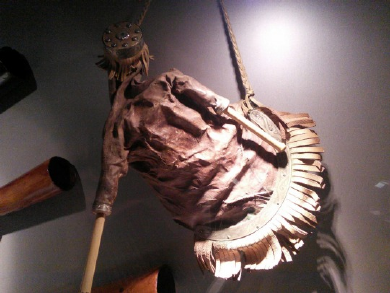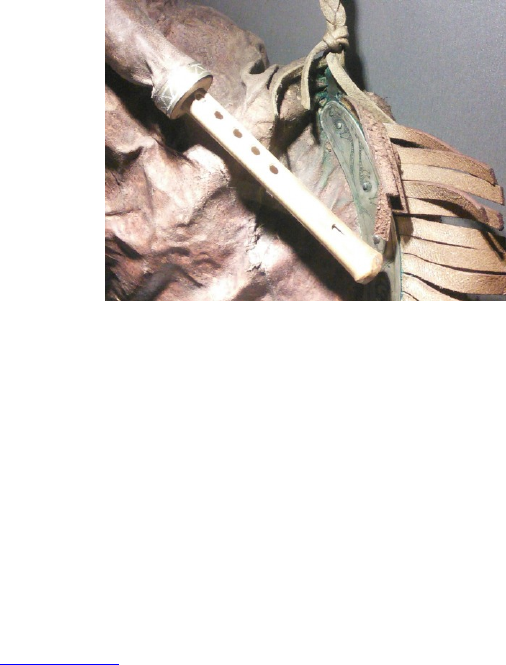The Bagpipe Society
The Zhelbuaz: is this Kazakh bagpipe real?
One of the more unexpected highlights of my recent trip to Central Asia was the Musical Instrument Museum in Almaty, former capital of Kazakhstan. Unlike most museums in the region, which don’t seem to have been updated since the 1970s (if that recently), it’s well displayed and even quite well labelled, in Kazakh, Russian, and (handily) English.
About nine-tenths of the instruments displayed are strings, whether plucked (dombra) or bowed (kobyz)m as well as harps and zithers. However, there are some interesting wind instruments too. The ocarina is a popular folk instrument in both Kazakhstsn and Kyrgyzstan, which share a similar nomadic culture; various types of flutes and whistles are found, as are long wooden ’trumpets’. Overtone flutes appear to be common, as is the jaws harp; many of the flutes have only three or four fingerholes. There are also a couple of what appear to be versions of pibgorn. In the wing devoted to instruments from other countries, I was surprised to find a number of bagpipes, including a couple of East European bagpipes and a veuze which appears to have had the drone replaced by a biniou koz chanter. (That may well indicate that no one among the staff actually knows how bagpipes are intended to function.)
Even more fascinating, though, is the single example of the zhelbuaz, a Kazakh bagpipe. The bag is made out of a whole goatskin, the neck stopped by a wooden disk with metal ornamentation. Each of the front legs contains a stock, and each stock contains a reed (or bamboo?) pipe of equal dimensions (130-150 mm in length and between 15 and 25mm in width; that’s a rough estimate, as the zhelbuaz hangs quite high and quite far back in its glass case, added to which the light bulb was flickering on and off alarmingly, so that I had to make observations in the intermittent periods of full brightness). The bottom of the bag is stitched tight with a leather fringe, and there is a leather strap allowing the player to suspend the zhelbuaz around his or her neck. It’s a beautiful piece of work, but there was no more information. No one at the museum knew anything about it, and I couldn’t find anyone who played it. CDs on sale in local shops didn’t include any zhelbuaz tracks and I have never as much as glimpsed a zhelbuaz in any of the Kazakh folk orchestras, despite perusing numerous videos. (A Google search on ‘Kazakh bagpipes’ gets you a reference to a GHB player who has links to Kazakhstan.)


The more I looked at the instrument the more puzzled I became. First of all, the ‘chanter’ has five fingerholes - indicating a very limited range of notes - but also has, towards what seems to be a closed node at the bottom, what appears to be a tongue cut out of the reed but could just possibly be a tuning hole. The other tube is, I suppose, the mouthpiece; if so, there is no drone.
I looked for more information on the instrument. I cannot find another example of it. Every mention of the zhelbuaz comes back to this single instrument. And most of the mentions are unenlightening; for instance Gultar Kendirbaeva describes it as an instrument “featuring two reed pipes, two tongues, and numerous holes”. Despite the fact that the museum describes it as a 20th century instrument, and that appears likely given the sophistication of the metalwork, another anonymous source describes it as coming from an archaeological site.
I have a suspicion that the zhelbuaz may be, perhaps not a hoax, but an instrument that has been stuck together from spare parts, or wrongly reassembled. I’m particularly perturbed by my failure to find another copy anywhere (including in Kazakhstan’s National Museum), and by the odd state of display of the veuze (which appears to have changed between the video and my visit to the museum). I consoled myself for my failure to find a living Central Asian bagpipe tradition by heading off to buy a couple of ocarinas - and very nice they are, but they’ll never compete with a bagpipe!
**References
**Video (http://bit.ly/Chanter74) displaying but not playing the bagpipe: states that the instrument was intended to accompany singing. Kendirbaeva, Gultar: Folklore and Folklorism in Kazakhstan. Asian Folklore Studies, volume 53 no 1
(1994), pp 97-123.

- Data Processing Notice (GDPR)
-
@BagpipeSociety on X (formally known as Twitter)
-
TheBagpipeSociety on Instagram
-
 BagpipeSociety on Facebook
BagpipeSociety on Facebook
Something wrong or missing from this page? Let us know!
